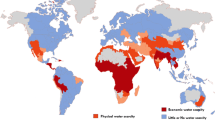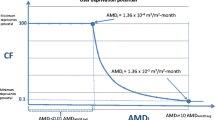Abstract
Virtual water trade can generate an aggregate value gain or loss when there is a regionally disparity in the value of water resources. This paper proposes a novel integrated model to evaluate the impact of virtual water trade on the gain and loss in both environmental and economic dimensions. Environmentally, when virtual water flows from regions rich in water to regions short of water, the scarcity of water resources at the aggregate level is alleviated and positive gains are obtained. Economically, as virtual water is transferred from economically less developed regions to those that are economically developed, the marginal economic value of water resources is enhanced, resulting in a positive gain. China is characterized by significant disparities in the degree of water scarcity and the level of economic development in different areas of the country. This study therefore focuses on China as a case of how interregional virtual water trade leads to a loss or gain in aggregate value. We employ a Multi-regional Input–Output model to analyze the virtual water flows within China and adopt the Data Envelopment Analysis to evaluate the water shadow price. Results show that the virtual water flow in China in 2015 was mostly from water-scarce to water-rich regions, resulting in a loss of 8 billion m3 of scarce water; however, at the same time, economically developed areas received large amounts of virtual water from less developed areas, thereby generating a net economic gain of 8.5 trillion CNY. In particular, the virtual water trade from Heilongjiang to Shandong yielded the largest of environmental gains, saving 1.65 billion m3 of scarce water, and the virtual water trade from Xinjiang to Guangdong produced the largest of economic gains, hitting 479 billion CNY. This paper aims to serve as an inspiration for regional, national and even global virtual water trade practices.
Graphical Abstract






Similar content being viewed by others
References
Allan JA (1993) Fortunately there are substitutes for water otherwise our hydropolitical futures would be impossible, priorities for water resources allocation and management. Overs Develop Adm 13(4):13–26
Allan JA (1998) Virtual water: a strategic resource global solutions to regional deficits. Ground Water 36:545–546
Badrul MM et al (2019) Global implications of regional grain production through virtual water trade. Sci Total Environ 659:807–820
Baležentis T, Dabkienė V, Štreimikienė D (2022) Eco-efficiency and shadow price of greenhouse gas emissions in Lithuanian dairy farms: An application of the slacks-based measure.". J Clean Prod 356:131857
Bo Zhang ZM, Chen XH, Xia XY, Xu YBC (2013) The impact of domestic trade on china’s regional energy uses: a multi-regional input–output modeling. Energ Polic 63:1169–1181. https://doi.org/10.1016/j.enpol.2013.08.062
Charnes A, Cooper WW, Rhodes E (1978) Measuring the efficiency of decision making units. Eur J Operat Res 2:429–444
Christopher L et al (2019) The US food–energy–water system: a blueprint to fill the mesoscale gap for science and decision-making. Ambio 48(3):251–263
Chuxiong D et al (2020) Interprovincial food trade and water resources conservation in China. Sci Total Environ 737:139651–139651
Colby, Bonnie G. (1989) Estimating the value of water in alternative uses. Natural Resources Journal (29)2: 511–527. http://www.jstor.org/stable/24883538
Dandan Zhao Y, Tang JL, Tillotson MR (2017) Water footprint of Jing-Jin-Ji urban agglomeration in China. J Clean Prod 167:919–928. https://doi.org/10.1016/j.jclepro.2017.07.012
Feng K et al (2014) Virtual scarce water in China. Environ Sci Technol 48(14):7704–7713
Førsund FR (2018) Economic Interpretations of DEA. Socioecon Plann Sci 61:9–15
Gassert F, Luck M, Landis M, Reig P, Shiao T (2014) Aqueduct global maps 2.1: constructing decision-relevant global water risk indicators. World resources institute, Washington D.C. United States
Guan D, Hubacek K (2007) Assessment of regional trade and virtual water flows in China. Ecol Econ 61(1):159–170
Han MY, Chen GQ, Li YL (2018) Global water transfers embodied in international trade: tracking imbalanced and inefficient flows. J Clean Prod 184:50–64
Hoekstra AY, Chapagain AK, Aldaya MM, Mekonnen MM (2011) The water footprint assessment manual: Setting the global standard. Earthscan, London, UK
Hoekstra AY, Hung PQ (2002) Virtual water trade: a quantification of virtual water flows between nations in relation to international crop trade (Value of water research report series No.11). Netherlands: UNESCO-IHE
Kao C (2009) Efficiency decomposition in network data envelopment analysis: a relational model. Eur J Oper Res 192(3):949–962
Laurène B et al (2018) Redressing the balance: quantifying net intercatchment groundwater flows. Hydrol Earth Syst Sci 22(12):6415–6434
Lenzen Manfred (2009) Understanding virtual water flows: a multiregion input-output case study of Victoria. Water Res Res 45(9):W09416-n/a
Lenzen M, Peters GM (2010) How city Dwellers affect their resource Hinterland. J Ind Ecol 14(1):73–90
Leontief WW (1941) Structure of american economy, 1919–1929: an empirical application of equilibrium analysis. Harvard University. Press, Cambridge, MA
Chai L et al (2018) Assessing life cycle water use and pollution of coal-fired power generation in China using input-output analysis. Applied Energy 231:951–958
Liao X et al (2021) Unveiling economic co-benefits of virtual water trades: An empirical analysis on China's JingJinJi megalopolis. Water 13(21):3140
Liu X et al (2009) Evaluating and predicting shadow prices of water resources in China and its nine major river basins. Water Resour Manage 23(8):1467–1478
Liu W, Antonelli M, Kummu M et al (2019) Savings and losses of global water resources in food-related virtual water trade. Wiley Interdiscip Rev Water 6(1):e1320
Liu A, Han A, Chai L (2021) Life cycle blue and grey water in the supply Chain of China’s apparel manufacturing. Processes 9:1212. https://doi.org/10.3390/pr9071212
Ministry of Ecology and Environment of China (2016) Annual statistic report on environment in China. https://www.mee.gov.cn/hjzl/sthjzk/sthjtjnb/
Molinos-Senante M, Mocholí-Arce M, Sala-Garrido R (2016) Estimating the environmental and resource costs of leakage in water distribution systems: a shadow price approach. Sci Total Environ 568:180–188
National Bureau of Statistics of China (2016) Statistical Yearbook of China. http://www.stats.gov.cn/tjsj/ndsj/2016/indexch.htm
National Bureau of Statistics of China (2020) Statistical Yearbook of China. http://www.stats.gov.cn/tjsj/ndsj/2020/indexch.htm
Organization for Economic Cooperation and Development. Environment at a glance 2015: OECD indicators (2015) Retrieved from www.oecd-ilibrary.org/environment/environment-at-glance2015_9789264235199
Paolo D’O et al (2020) The global value of water in agriculture. Proc Natl Acad Sci 117(360):21985–21993
Pfister S, Koehler A, Hellweg S (2009) Assessing the environmental impacts of freshwater consumption in LCA. Environ Sci Technol 43(11):4098–4104
Qian-wen Y, Feng-ping W, Zhang Z-F, Wan Z-C, Shen J-Y, Zhang L-N (2021) Technical inefficiency, abatement cost and substitutability of industrial water pollutants in Jiangsu province, China. J Clean Prod 280:124260. https://doi.org/10.1016/j.jclepro.2020.124260
Renault Daniel (2003) Value of virtual water in food: Principles and virtues. Hoekstra, AY (Ed.)
Ridoutt BG, Pfister S (2010) A revised approach to water footprinting to make transparent the impacts of consumption and production on global freshwater scarcity. Glob Environ Chang 20(1):113–120
Sabbaghi MA, Nazari M, Araghinejad S, Soufizadeh S (2020) Economic impacts of climate change on water resources and agriculture in Zayandehroud river basin in Iran. Agric Water Manag 241:106323. https://doi.org/10.1016/j.agwat.2020.106323
Salmoral G, Yan X (2018) Food-energy-water nexus: a life cycle analysis on virtual water and embodied energy in food consumption in the Tamar catchment UK. Res Conserv Recycl 133:320–330
Singbo AG, Lansink AO, Emvalomatis G (2015) Estimating shadow prices and efficiency analysis of productive inputs and pesticide use of vegetable production. Eur J Oper Res 245(1):265–272
The Ministry of Water Resources of China (2016) Water resources Bulletin. http://szy.mwr.gov.cn/gbsj/index.html
Wang Ke, Wei Y-M (2014) China’s regional industrial energy efficiency and carbon emissions abatement costs. Appl Energ 130:617–631
Wang W et al (2018) Sustainable water use and water shadow price in China’s Urban industry. Res Conserv Recycl 128:489
Wang Z et al (2019) Virtual water flow pattern of grain trade and its benefits in China. J Clean Prod 223:445–455
Wang L et al (2020) The drivers of export value-added in China’s provinces: a multi-regional input-output model. Appl Econ 52(57):6199–6214
Wichelns D (2004) The policy relevance of virtual water can be enhanced by considering comparative advantages. Agr Water Manage 66:49–63
Wu H et al (2022) Savings and losses of scarce virtual water in the international trade of wheat, maize, and rice. Int J Environ Res Public Health 19:4119. https://doi.org/10.3390/ijerph19074119
Wu H et al (2022) Interregional flows of virtual cropland within China. Environ Res Commun 4:075009. https://doi.org/10.1088/2515-7620/ac7fe3
Zhang C, Anadon LD (2014) A multi-regional input-output analysis of domestic virtual water trade and provincial water footprint in China. Ecol Econ 100:159–172
Zhao X, Liu J, Liu Q et al (2015) Physical and virtual water transfers for regional water stress alleviation in China. Proc Natl Acad Sci USA 112(4):1031–1035
Zhao X et al (2018) Measuring scarce water saving from interregional virtual water flows in China. Environ Res Lett 13(5):054012
Zhao D, Hubacek K, Feng K, Sun L, Liu J (2019) Explaining virtual water trade: a spatial-temporal analysis of the comparative advantage of land, labor and water in China. Water Res 153:304–314
Zheng H, Zhang Z, Wei W, Song M, Dietzenbacher E, Wang X, Meng J, Shan Y, Jiamin O, Guan D (2020) Regional determinants of China’s consumption-based emissions in the economic transition. Environ Res Lett 15(7):074001. https://doi.org/10.1088/1748-9326/ab794f
Zhuo L, Mekonnen MM, Hoekstra AY (2016) The effect of inter-annual variability of consumption, production, trade and climate on crop-related green and blue water footprints and inter-regional virtual water trade: a study for China (1978–2008). Water Res 94:73–85
Ziolkowska JR (2015) Shadow Price of Water for irrigation—A Case of the High Plains. Agric Water Manag 153:20–31
Acknowledgements
This work was supported by Beijing Natural Science Foundation (9204027) and the National Key Technologies R&D Program of China (2022YFD1500205)
Funding
This work was supported by Beijing Natural Science Foundation (9204027) and the National Key Technologies R&D Program of China (2022YFD1500205).
Author information
Authors and Affiliations
Corresponding author
Ethics declarations
Conflict of interest
The authors have no relevant financial or non-financial interests to disclose.
Additional information
Publisher's Note
Springer Nature remains neutral with regard to jurisdictional claims in published maps and institutional affiliations.
Rights and permissions
Springer Nature or its licensor (e.g. a society or other partner) holds exclusive rights to this article under a publishing agreement with the author(s) or other rightsholder(s); author self-archiving of the accepted manuscript version of this article is solely governed by the terms of such publishing agreement and applicable law.
About this article
Cite this article
Han, A., Liu, A., Guo, Z. et al. Measuring Gains and Losses in Virtual Water Trade from Environmental and Economic Perspectives. Environ Resource Econ 85, 195–209 (2023). https://doi.org/10.1007/s10640-023-00763-9
Accepted:
Published:
Issue Date:
DOI: https://doi.org/10.1007/s10640-023-00763-9




